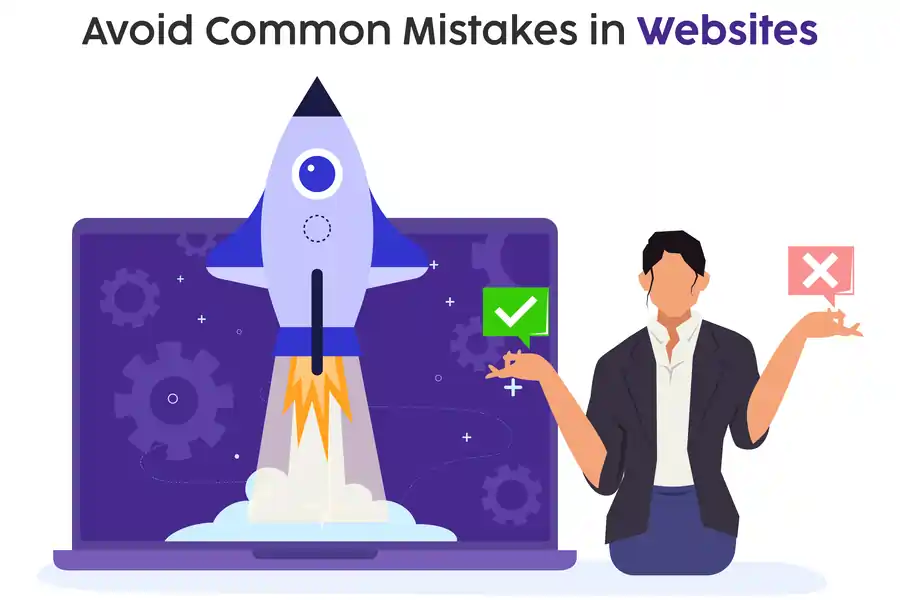Launching a website requires meticulous planning to avoid pitfalls that can hinder performance and user engagement. Common mistakes include neglecting SEO, poor navigation, and lack of mobile optimization.
Highlights
An enthusiastic developer and skilled business management expert with over a decade of experience in the field

Building a website is an interesting but difficult task. Whenever one is launching a project, no matter if it is for a business establishment, a personal project, or an online shop, various methods have to be launched, which require a lot of planning. However, there are multiple errors made in this process that can lead to inability, costly mistakes and disappointed users. Just as we have seen many challenges that can affect the smooth launch of a product, it is also important to point out there are mistakes that could be avoided. This article will explain to you more about the most used mistakes likely to happen and the way to avoid them while creating your site.
One of the most common mistakes people make is not having a clear purpose and goal for the website. Before starting website development, need to understand the purpose of your site and its niche
ASK yourself
If these questions are not answered, your website can look messy and difficult for visitors to guide. Clear goals make one see that every part on site supports the vision and only the requirements are included.
UX stands for user experience and deals with how users or visitors experience your website. If your website is not easy to understand, slow to load, or has a confusing interface, visitors will likely leave without tracing any content. This can be harmful towards your business or your website.
Make sure your site
Sites, such as Google Page Speed test, can help you understand how well your site performs on various types of devices.
Planning to build a news website? Learn how to create a successful news platform and monetize it.
As users increasingly visit sites on mobile devices. If your website looks good on a desktop, except mobile, you are missing out on a large audience. Responsive web design makes sure your website adjusts automatically to fit any screen size, providing a consistent experience.
Check your site on different devices to know how your navigation, images and texts look on small screens. To give an example, the usage of design, which should be modified for any screen automatically, is one of the essential parts of modern web development services
The content you post on your website is as important as the looks of it. However, it is incredible to see that there is a common trend where many people pay attention to the design and overlook the content. Without useful, relevant content, visitors won’t stay long or come back.
Plan out your website content in advance
Furthermore, you might also bring in new content, and add a blog or resources section of the site to continue to add updates.
Sometimes, people want to include too many features on their website, such as animations, pop-ups, or complex functionality. Even though might be cool to have a lot of options, that just makes users confused or the site is simply too slow.
Rather than overloading your website with multiple features, focus on simplicity and ease of use. Keep the design clean and avoid unnecessary elements that might distract users.
Search engine optimization (SEO) is what helps your website seem in search engine results. Many people forget to include SEO techniques when establishing a site, leading to poor search rankings and little organic traffic.
To avoid this, make sure that you:
To attract more visitors in the long run, investing in SEO during the development process is very important.
If your website takes more time to load, users will leave before they even see your content. A slow website can prevent users and harm your search engine rankings.
You can avoid this by
A fast website not only keeps users satisfied but also increases your chances of ranking higher on search engines.
Security should always be of major concern when launching a website, specifically if it concerns collecting personal information or processing transactions. Ignoring security puts your site at risk of getting attacked or breaking, which can damage your reputation and lead to legal issues.
Some key steps to take include
If you want web design services, or you want to develop a site that requires users to input personal details, then you should take these measures as mandatory.
One of the biggest mistakes people make is not testing their newly built website before opening it for the public to see. It comes down to a simple guide every part of the website from the back end to the front end, must be properly tested by QA(Quality Assurance)
Before launching, test the following:
Confirming that you have tested the website to avoid future problems and give users a better experience.
Learn How Whatsapp Automation For Individuals and MSME helping them to increase there Business Benefits of Whatsapp.Let DIGITTRIX help you to integrate Whatsapp API into your websiye or mobile app.
A call to action (CTA) lets the users know what action to take next whether it be to subscribe to a newsletter, get more information or buy a product. Without clear CTAs, users may not understand how to connect with your site or what actions to take.
Your CTA should:
However, well-developed business calls-to-action help users and improve website efficiency.
To host the website you have to be very careful because the choice of hosting provider will impact your site a lot. Others prefer minimal hosting plans, which often result in slow loading times, poor security, and much downtime.
This is an important factor because you will be selecting from many web hosting services in the market and some of them will not suit the needs of your company or organization. Consider factors such as customer help, security, and flexibility when selecting your provider.
A good hosting provider also guarantees that your website runs optimally and possibly better than when it was first hosted.
Many people dont track the website traffic, behaviour and engagement using analytics tools. This being the case, if you do not have this data you cannot tell how your website is processed or even the areas you need to increase.
Set up analytics tools such as Google Analytics to track your users. This will allow you to:
Checking your website performance regularly can help you make critical adjustments to expand user experience.
Images are an important factor in affecting the outlook of a website. However, low-quality or not optimized images can harm the overall impression of your site and slow down its performance.
Make sure to:
By choosing suitable images and optimizing them for the Web, you can make both the aesthetic and functionality of your site further developed.
Imagine launching your website, and then it crashes, or any other technical issue. The risks present include that if you do not have backups then your content and settings are in a helpless situation. Generally, people do not plan on backups, and their websites could be at risk in case of a disaster.
This can be prevented by employing the services of a good backup service or plugin that backs up your site frequently. That way, if something wrong happens then you will be able to recover it from the backup you have of the site.
While a visually appealing website is important, overly complicated designs can confuse and complicate usability. Simple, clean designs are often more useful and user-friendly.
To avoid this mistake:
A straightforward design helps users on track of what is relevant and lets everyone get to where they want to go on your site.
Launching a website needs a lot of planning and consideration. The challenge is that such pitfalls can be hard to avoid, which is why it's crucial to prevent them to provide a good user experience. Don’t forget the importance of user experience and working on speed and security while focusing on content and design as well as SEO. In this way, you’ll develop a website that is both practical as well as interesting for clients. If you have employed the services of a web development company or you are developing your site on your own, these tips will guide you and ensure you dont fall short of the ideal start.
At DIGITTRIX, we ensure to avoid common mistakes during website development.With Over, 14 years of Experience and 1000s of Project Delivered to Client Servers
We Can help you in Website Development by keeping in mind not to follow Common Errors that 90% of IT Companies do
If you're interested in building a Website but are unsure how to start, schedule a consultation today with our co-founder by sending a WhatsApp message here at +91 8727000867
You can also write to us with your queries at digittrix@gmail.com

Do you need help in Web Development ?




Join over 1500+ businesses we've already helped!
You can avoid mistakes by setting clear goals, optimizing UX, ensuring mobile-friendliness, planning content, and focusing on security and SEO.
Slow website speed can drive visitors away and negatively affect search engine rankings. Fast-loading sites improve user experience and SEO performance.
A mobile-friendly website ensures a consistent experience across all devices, attracting more visitors and improving search rankings.
Improve security by using SSL certificates, regularly updating software, using strong passwords, and implementing multi-factor authentication.

©2025Digittrix Infotech Private Limited , All rights reserved.